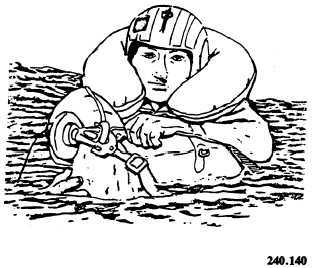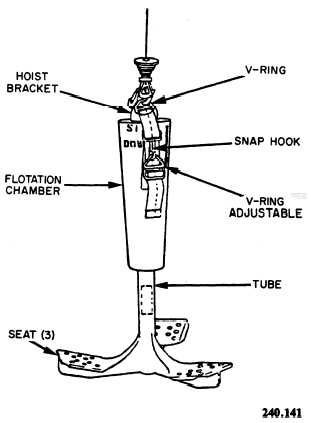sea rescue operations and is designed to accom-
modate one, two, or three survivors at a time;
however, one at a time is best for entrance into
the helicopter. During land rescue, the forest
penetrator is lowered to the survivor with the three
seats in the retracted position; during sea rescue,
it is lowered with the flotation collar installed, a
safety strap hanging free, and the three seats in
the retracted position. In this configuration, the
penetrator will float with its top 6 inches above
the surface of the water.
The following is a step-by-step procedure for
the survivor to safely use the forest penetrator:
1. Lower the visor on your helmet as you wait
for the rescue device to enter the water.
2. Swim to the forest penetrator and lower
one of the three seats. Sit on the lowered seat
facing the flotation collar.
3. Grasp the free end of the safety strap and
pass it around your body. Attach the adjustable
quick-ejector snap to the forest penetrator and
tighten the strap as shown in figure 5-32.
4. Give a thumbs-up signal to the hoist
operator. As you are lifted from the water, put
your arms around the penetrator and tuck your
head down.
Forest Penetrator With Flotation
Collar (Swimmer-Assisted Rescue)
During swimmer-assisted rescues using the
f o r e s t p e n e t r a t o r w i t h f l o t a t i o n c o l l a r , t he
Figure 5-32.—Attaching the forest penetrator.
swimmer uses the following procedure to attach
the survivor to the hoist cable:
1. After the penetrator is in the water, pulls
down a seat for the survivor to sit on, facing the
penetrator.
2. Disconnects a safety strap, passes it under
the survivor’s arm, around the back, and under
the other arm. Reconnects the strap and tightens
it.
3. Has the survivor wrap his arms around the
penetrator.
4. Signals the aircraft “ready for hoist.”
5 . A f t e r t h e s u r v i v o r i s h o i s t e d t o t he
helicopter, the crewman assists the survivor into
the helicopter.
Rescue Seat
The rescue seat can be used to lower and hoist
personnel performing rescue operations from a
helicopter over land or water. The rescue seat is
designed to accommodate one survivor at a time.
It is a buoyant aluminum device consisting of a
hollow flotation chamber, a three-pronged seat,
and a safety strap (fig. 5-33).
Figure 5-33.—Rescue seat.
5-24



